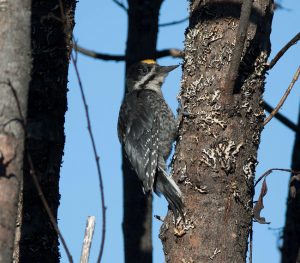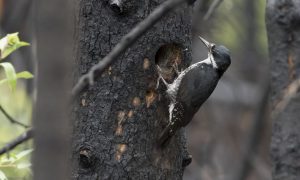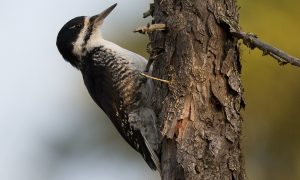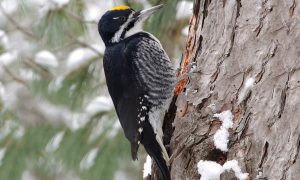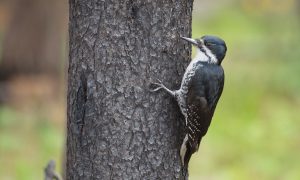Black-backed Woodpecker
The North American woodpecker is a sexually dimorphic species. Primarily foraging on burnt-forests, the woodpecker prefers open woodlands for nesting and thriving.
Scientific Classification
| Kingdom | Animalia |
| Phylum | Chordata |
| Class | Aves |
| Order | Piciformes |
| Family | Picidae |
| Genus | Picoides |
| Scientific Name | Picoides arcticus |
Quick Information
| Also Known as | Arctic three-toed woodpecker |
| Description | Size: Around 9.1 in (23 cm) Weight: 2.1-3.1 oz (61-88 g) Color: Black body, with white underside( throat to belly), white itsy-bitsy patterns on wings, male woodpeckers exhibit a yellow cap |
| Distribution | Canada, states like Minnesota, Alaska, Wisconsin, Upper Michigan, and American Northwest |
| Habitat | Boreal forests |
| Sounds & Calls | Sharp and single “pik” |
| Lifespan | 6-8 years (estimated) |
| Diet | Woodboring beetles and bark beetles larvae |
| Adaptation | 1. The claws are strong and the tail is stiff so the bird can firmly sit on the tree bark vertically 2. Both the skull and the beak of the bird are strong so that the bird can excavate the tree fast |
| Predators | Cooper’s Hawk, northern flying squirrels, and red squirrels |
| IUCN Conservation Status | Least concern |
Behavior
- The black-backed woodpecker flak off the bark of dead trees to search for insects.
- Both male and female woodpeckers indulge in the excavation.
Mating and Reproduction
Either by emitting some harsh calls or some courtship gestures, the male and female woodpeckers mates. Next step is to make a nest at 20-15 in off the ground, on dead pine or spruce. This is mostly done by the male as the female gets ready for laying around 3-6 white eggs in the nest. The incubation period lasts for 12-14 days. It is a shared duty by both the parents and males are mostly incubating at night. The breed once in a year.
Life-cycle
Young hatchlings are fed by their parents with male woodpeckers fly out to collect food away from the nest. They might undertake several trips for gathering food for their offspring. The juveniles woodpeckers need around 25 days to fledge.
Interesting Fact
- The black-backed woodpecker has three-toed feet.
References
- https://www.audubon.org/field-guide/bird/black-backed-woodpecker
- https://www.allaboutbirds.org/guide/Black-backed_Woodpecker/id
- https://www.borealbirds.org/bird/black-backed-woodpecker
- https://fieldguide.mt.gov/speciesDetail.aspx?elcode=ABNYF07090
- https://www.sierraforestlegacy.org/FC_SierraNevadaWildlifeRisk/Black-backedWoodpecker.php
- https://bwdmagazine.com/learn/black-backed-woodpecker/
Published on August 9th 2019 by Sahana Kanjilal under Coniferous Forest Animals.
Article was last reviewed on 5th December 2022.


